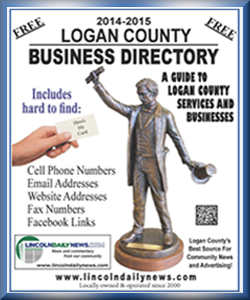 And fittingly, it is in a town that was originally surveyed by a
young, laboring A. Lincoln and a few years later named for and
christened by the young lawyer, who subsequently became an attorney,
became a state legislator, became a congressman, and now is a
second-term president. And fittingly, it is in a town that was originally surveyed by a
young, laboring A. Lincoln and a few years later named for and
christened by the young lawyer, who subsequently became an attorney,
became a state legislator, became a congressman, and now is a
second-term president.Less than nine weeks pass ...
It is April 14, 1865. During the thrill of a lively play already
in process at Ford's Theatre in Washington, D.C., President Lincoln
and his wife, Mary Todd, arrive, a little late. As the play
continues, suddenly shots ring out, pandemonium ensues, and after
several moments of chaos, all falls silent.
149 years pass ...
It is now April 2014. You are on the campus of Lincoln College,
not far from University Hall, which yet stands. You are on the
second floor of the newly redesigned Lincoln Heritage Museum.
And today, by means of the most sophisticated modern technology,
you have just experienced what it may have been like to actually be
standing in Ford's Theatre watching as those tragic events unfolded.
Furthermore, you will now continue your walk backward in time as an
active observer to experience in a manner as never before, some of
what may have been the pivotal moments in the life of Abraham
Lincoln.

Lincoln Heritage Museum curator Ron Keller and assistant director
Anne Moseley worked in tandem with interpretive planning and exhibit
design experts from Taylor Studios of Rantoul. The work has been
expertly blended into a presentation that uses modern concepts in
lighting, audiovisual and video technologies to bring a sense of
presence to displays and scenes; Lincoln's life comes alive.
While you partake in one of the optional, timed experiential
walking tours, you may find yourself doing more than stepping into
the shoes of Abraham Lincoln. The series of exhibits and displays
use authentic and reproduced items of significance that are set into
real-life surround stages that are fully touchable and interactive —
intended to transport you into the days that Lincoln lived.
You are encouraged to touch the displays. Keller said, "We do
invite people to touch things, get into history and feel it."
Feel the impact of documents, maps, posters and relics grouped
and presented in life-sized displays. Strategically selected events
illuminate whence Lincoln's convictions, strengths and actions may
have come. And likely, you will be challenged to review your own
contributions in life.
You are presented pieces of Lincoln's earlier life that indicate
what may have given him the resolve necessary to lead a young
country through one of its most trying times; to unite, even grow,
as California knocked on its door; or to fail, splinter and dissolve
in dissension over the issue of slavery.
As you progress backward through time, you will gain a greater
sense of what may have gifted Lincoln to be the leader needed for a
country in what was surely its greatest struggle to unite as a
nation of one accord.
One of the exhibits includes reproduced slave posters, a map and
pictures of the working flatboat journey that young Lincoln took
down the Mississippi, where he would have seen slaves openly
marketed on the streets of New Orleans.
According to Keller, historical accuracy was a primary
consideration. "Every word you hear in the audios has been verified
as actual statements made by Abraham Lincoln or others," he said.
"We don't want to take any liberties with history. We want to tell
it like it was."

Carefully selected life-moments foreshadow decisions that led to
dynamic changes of our then less-than-century-old country. You will
journey backward through the personal moments and events that molded
the man who crafted words with such power that they are some of the
most noted in this country's history — speeches that kept a country
from coming apart. Documents, debates and speeches, such as his
Second Inaugural Address in the midst of the Civil War, stand out
yet today.
Like a good movie that pulls you in and makes you feel at one
with the main character, at some point you may find yourself walking
in Abraham Lincoln's shoes. Scenes are set using authentic or
replicated items of significance: a room of family portraits; a
walk-in Civil War commander's tent with lantern and maps; a
courtroom with pieces of evidence from the common cases Lincoln
argued; speeches; national decrees of freedom for the oppressed; the
hand-built coffin Lincoln made for his mother. You are looking and
thinking back over clarifying moments — the who, what and where —
that in combination with the character and qualities of Abraham
Lincoln may have been what destined him to his life extraordinaire.
[to top of second column] |

As you move from one scene to the next, backward through time,
you will feel Lincoln's personal losses and sorrows, see his
increasing strength of commitment and intent. Audibly, the cadence
of tock, tock, tock, tock steadily increases in volume. The measure
of time seeps into your awareness.
The calculated re-creation makes it as though you are walking
with Lincoln, you are Lincoln, reviewing his life from the time he
is shot to the time that he dies. As you take that walk with him,
the tick of a clock grows louder, imploring that you, like him,
might take stock of your own life and live with purpose and intent
to make a difference.
The new location in the Lincoln Center not only expands the
exhibit space fourfold but also adds storage space. Plans include
regularly changing displays on the main floor.
The climate-controlled space will not only help preserve the
priceless relics the museum owns, but also open the doors to
opportunities to host other traveling exhibits.
In review, Keller considered what design elements cost today and
the time that Taylor Studios spent coming back again and again to
make everything just right. He was very pleased by the results and
the costs. "We realize how good of a deal we really did get," he
said.
About A. Lincoln
Being self-taught, Abraham Lincoln often made note of the
importance of education.
He frequently felt inferior in his presentations. Yet, Lincoln
penned some of the most powerful speeches and national decrees in
our country's history. Today, 149 years after his passing, he is
hailed as one of the most significant speakers and writers in
American history. Schoolchildren study and memorize works such as
his Emancipation Proclamation; he is known worldwide and often cited
and quoted by leaders still today.
Lincoln College President John Blackburn says that the college
embraces Abraham Lincoln's legacy.

"At Lincoln College we want every student to have an outstanding
college experience, and the Lincoln Heritage Museum will play a
vital role in that mission," said Blackburn. "We are excited to
showcase the museum's great treasures and stories and to connect
those things with our academic programs and campus life. The museum
will provide opportunities for students from many backgrounds to
shape their own success stories through Lincoln College."
A Lincoln College trustee, Susan Hoblit, whose ancestors often
hosted Lincoln at their rural homestead near Atlanta as he traveled
to Bloomington, coined the new phrase for the college and museum:
"Learn like Lincoln. Live like Lincoln."
A trip to the museum adds new perspective to the life and world
that Lincoln lived in. It is history to be experienced.
The museum is not only a treasure to the community in knowing A.
Lincoln better, but also will bring visitors to learn more of and to
experience Abraham Lincoln.
On campus, University Hall still stands and is in use today for
both classrooms and administrative offices.
The Abraham Lincoln National Heritage Area, managed by the
Looking for Lincoln Heritage Coalition, is in central Illinois.
There are numerous historic sites throughout Logan County where
Lincoln traveled, practiced law and gave speeches.
The college, the town of Lincoln and the county of Logan offer
the most condensed opportunities to walk in the footsteps of a man
who lived with intention and greatness in helping all mankind.

The newly redesigned and expanded Lincoln Heritage Museum now
offers everyone the opportunity to come and experience the life of
Abraham Lincoln on a fresh and personal level.
[LDN]
Lincoln Heritage
Museum:
Website |
Facebook |